
20070421
On our spring visit to Tucson, I decided to visit a local attraction that I have never seen -- the Titan Missile Museum. The museum is part of the Pima Air Museum group and managed by the same highly competent group of folks. The museum's web site has the whole story of the museum as well as directions to its location. Grossly, it is south of Tucson about 30 miles near the Duval copper mine. During the cold war, there were 18 sites within 60 miles of Tucson. The Titan missiles are still used as boost vehicles for the U.S. space program. In fact, I worked on this program briefly as part of my very first job out of college. The Titans served as a major deterrence during the cold war. Each of these bad boys carried an 8 megaton warhead, the largest ever produced by the U.S. (according to the tour guide). There were Titan bases in Arkansas and Nebraska as well as Arizona. Each of these set of bases were spread out over a large area to make them harder to destroy. Survivability was one of the key components of the US's mutually assured destruction (MAD) strategy. As grim as that strategy seemed, it worked as no documented nuclear exchange ever occurred. However, a recently published book claims that a rogue Soviet sub attempted a nuclear launch against Hawaii but the launch vehicle blew up in the launch tube aborting the mission and sinking the sub. The sub was later raised to the surface by the CIA as part of "Project Jennifer" by the Glomar Explorer. Read the book "Red Star Rogue" for the full story.
Near misses aside, these sites were huge engineering project-. The silos were hundreds of feet deep and contained the missile, its launch crew, the command and control room as well as living quarters. No dollar figure was given for the construction, but I am sure that the whole program was immense. If you throw in the development of the 8 megaton thermonuclear weapon as well as missile R&D into the mix, the total cost would be off the chart. Since I was a child of the cold war, and I grew up in Tucson knowing that if there was a nuclear exchange the whole valley would be toast due to the presence of the sites, it was a very meaningful visit. These sites were in service over 20 years, but were decommissioned as part of the SALT treaty. Happily, they were never tested. The photos below are what we saw.

A stern warning greeted all outsiders. There were always lots of security teams on the road in the Tucson area when I was a kid.

A large discone antenna used for communication with SAC headquarters and the NMCC.

The actual site was not that large, perhaps 200 meters square. The far edge of the facility is visible at the phone poles in the left center of the photo. Visible here are the blast doors and siren used to warn of an impending launch. That would not be a good sound to hear. A security jeep and fuel trailer are visible at the right of the photo above.
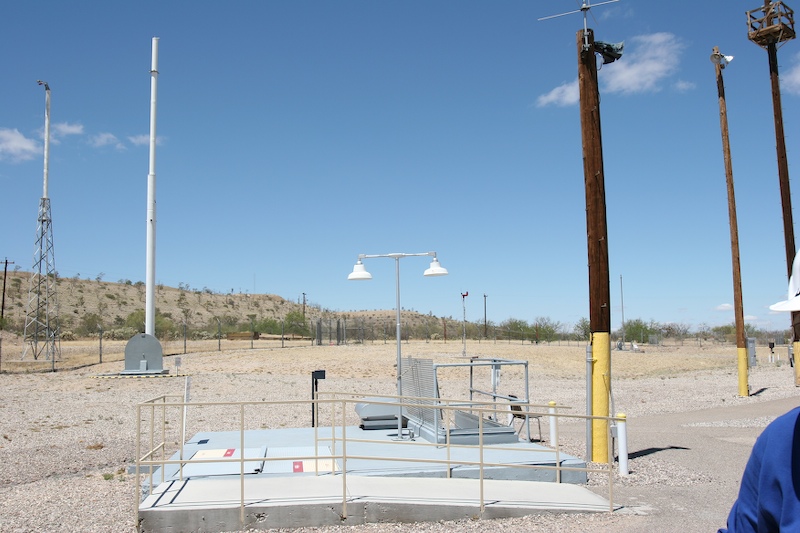
This is the crew access portal. The door is open for the tour. Also in that portion of the structure is an elevator for equipment maintenence. The white tower on the left was a pop-up antenna for emergency communications. The antenna was stored under its own blast door so it would survive an attack. The blast door is the 1/2 round door at the base of the white pole.

The machine in the center of the photo is an evaporative cooler used as part of the air supply. Also visible in this photo is another pop-up antenna in it's retracted position. In the distance is the overburden and tailings from the Duval mine.

As kids, we saw these on the roads on the outskirts of town frequently.

Fuel loading area. The Titan ran on a mixture of unsymmetrical dimethyl hydrazine and nitrogen tetroxide, both highly toxic as well as being explosive. The loading process was dangerous and a big, big deal. In shots below on this page, I have a photo of the space suits that the crew had to wear to survive a fueling operation.
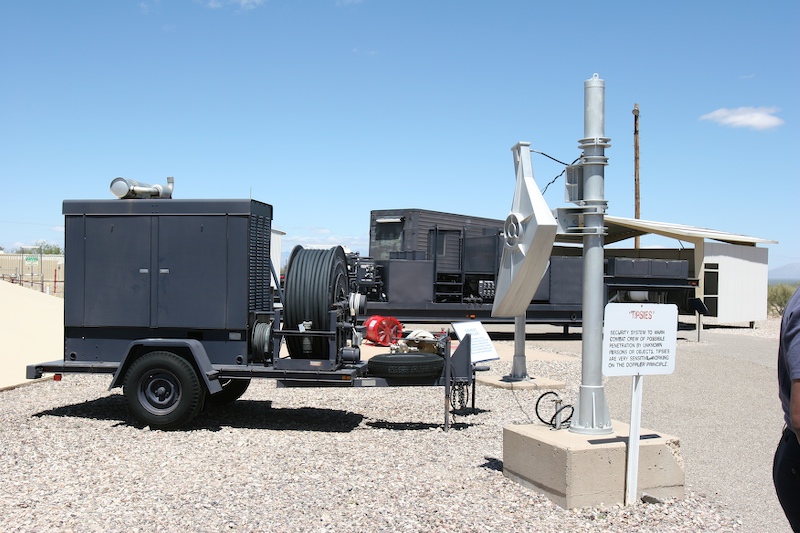
Ground support equipment and a doppler microwave personnel intrusion detection system called a "tipsie" The silver horn of one end of a tipsie is visible on the silver pole.
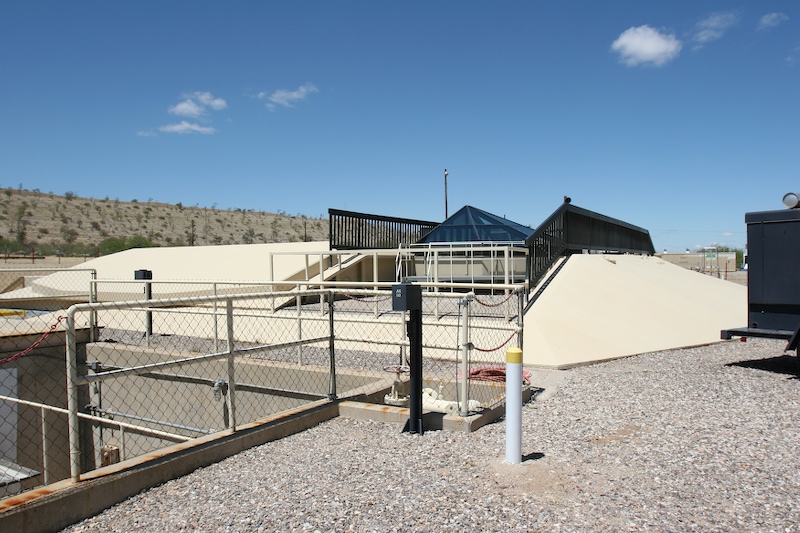
A viewing area overlooking the silo has been created by the doors being 1/2 open as required by the SALT treaty.
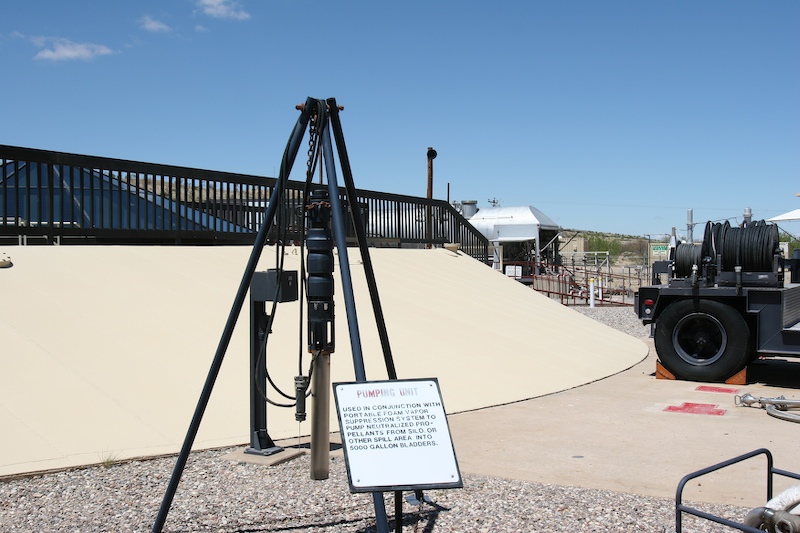
Back in those days, the military was not very ecologically minded. In fact, some of the worst pollution in the U.S. came from cold war times including Mare Island (nuclear fuel rods and decommissioned submarine parts), the Hanford Nuclear Reservation and the Nevada Test Site. But, the fuel and oxidizer were so toxic that spill containment had to be a priority lest it render the entire facility unusable. This was an evacuation pump assemply.
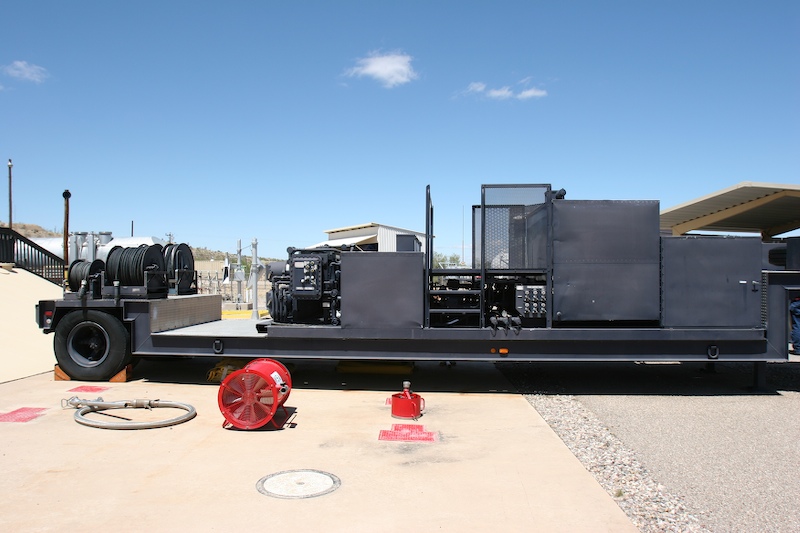
More of the propellant recovery support equipment.

Airborne support equipment used to move crews and security personnel. These "hueys" were the standard helicopter of the era.

First stage boost motor for the Titan. This is a dual nozzle system.
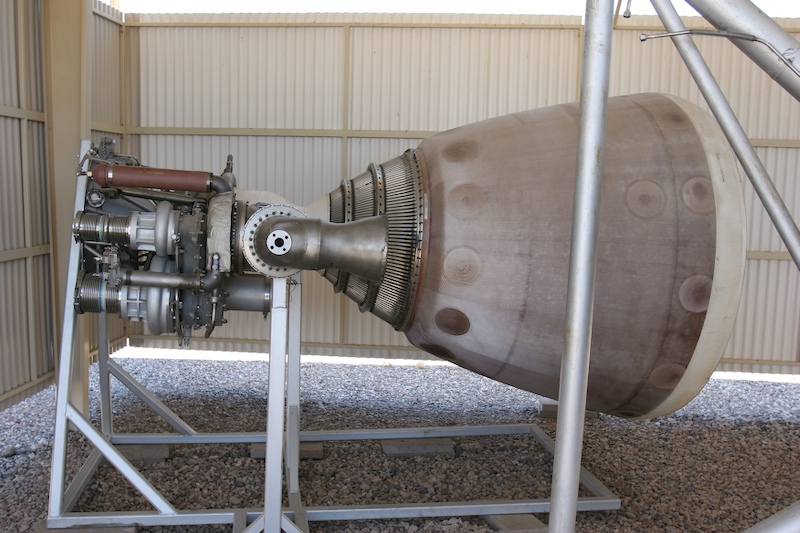
Second stage boost motor. These were big, complex motor assemblies that required precision components that could withstand the corrosive propellents, high pressures and high temperatures.

Nitrogen tetroxide pumping station. NO5 was the oxidizer for the fuel.

This wash stand was stardard equipment at every loading operation. The fuel is nasty stuff, but provided very powerful thrust.

A view of the missile from the 1/2 open blast doors above. The warhead would have been under the nose cone. Note stands around the perimeter of the silo that would be used as part of servicing procedures.

The blast doors are blocked at the 1/2 open point per the SALT treaty. The blocks are the concrete boxes behind the docent. We are heading to the crew entry portal for a trip below. The museum itself is the building in the distance. Also visible are the overburden hills from the Duval mine.

A view of the facility before we go underground. With the exception of the jeep, this is just how the facility looked during the 20 year operational life of the program. The blast doors were designed to withstand a direct nuclear hit. Gladly, that capability was never demonstrated.

The outer blast door. This door weighs 6,000 pounds and is supported by needle bearings lubed once per year. The hinge for the door is visible in the lower center of the photo. The doors had milled surfaces with rubber seals to keep radioactive contamination from getting inside the silo. The door is 6 inches of solid steel. Kathleen got a chance to move the door and she stated that it was smooth and easy to move. There were several sets of doors in series to provide protection for the launch crew and the missile itself.

Going into the command area through a cable bridge that is suspended on shock absorbers to allow surviveability of a direct nuclear strike. This configuration allowed the cable bridge to absorb the shock without ripping the cables. More on this later.

The command center. Here the docent gives us the briefing on what the launch sequence would look like and how it would be executed. The entire command center was a "no lone zone" where at least 2 personnel were required to be together at all times for both safety and security reasons. The thought was this procedure would prevent sabotage and/or rogue actions.

The red box is the duty safe with 2 locks. The safe contained the launch keys, authentication codes and classified documents. Both primary and deputy command officers had to be present to open their locks. The locks were assigned to the crew members and were used for the duration of their assignment at the site. During crew changes, the locks were changed as well, but one at a time. The center rack is commo equipment with dials indicating the state of the cummunications gear.

Environmental controls and monitoring for the missile. The propellant combination utilized by the Titan had a narrow temperature band for operation and therefore required substantial air conditioning to maintain the correct operating temperature.

As stated above, the facility was designed to withstand a direct nuclear blast. The central command center was suspended in a cavity and protected by sets of these springs.

Also part of the blast proofing were loops of cable slack in case of large ground motion resulting from the blast.

Chemical protection suits that had to be worn during a fueling operation. Note the checklist on the zipper. At a site with nuclear weapons and toxic fuels there is no free will. All operations were done by checklists only.

A view into the silo from the crew access port. The only reason that tourists were allowed in this silo is because this particular missile was only for training and had therefore never been fueled. Once fueled, the entire airframe becomes toxic, even after being pumped dry.

Dummies in rubber suits give an impression of what a fueling operation would have been like. This must have been scary, scary duty.

A view down the main cable way. Note that this cableway is also suspended and protected by springs and shock absorbers.
This was spooky for me given I lived in the area during the Cold War and the Cuban missile crisis. I never realized how much technology went into building and operating these silos. No wonder the Cold War cost a fortune. Russia eventually fell not because of a military victory, but rather they went broke trying to keep up with U.S. spending on technology. Meanwhile, the American taxpayer footed the bill. I guess, given the possible alternate outcomes, this was a good thing. It is true that much of the aerospace technology in use today had its roots in the Cold War including lasers, integrated circuits and the aerodynamic technology employed in the space shuttle.